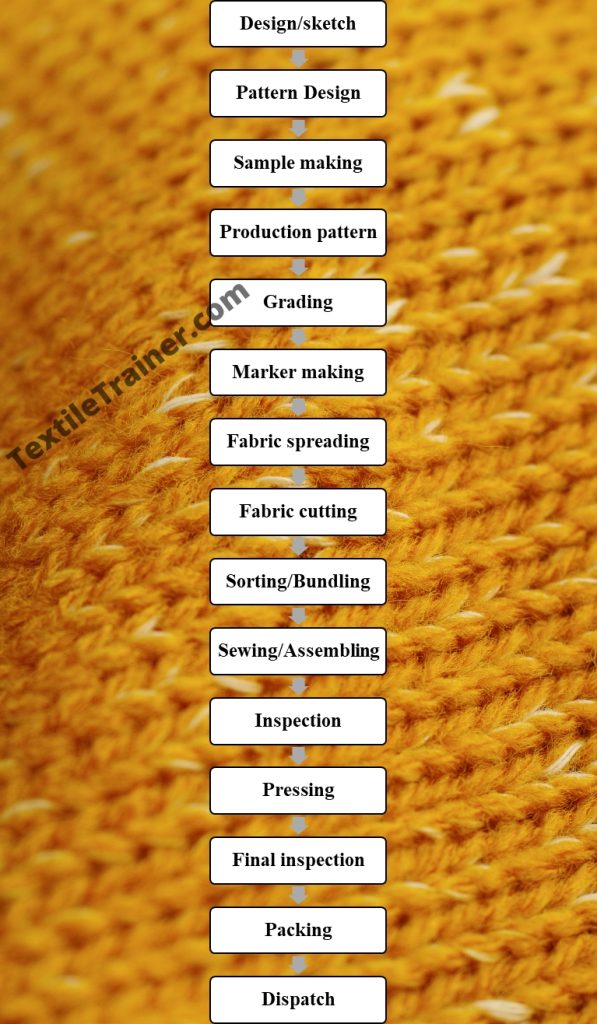Name of the Experiment:
study on modern flow chart of garments manufacturing.
Introduction:
The apparel industry is vital in meeting the global demand for clothing and textiles. Fashion trends have constantly evolved, and the customer base has become increasingly demanding, making it imperative to create efficient and streamlined manufacturing processes. Flow chart of garments manufacturing is one of the most essential tools in the apparel industry. It outlines the sequential steps involved in turning raw materials into finished garments. A garments manufacturing flow chart provides a detailed overview of the production process, from initial design and pattern making to cutting, sewing, finishing, and packaging. Providing manufacturers with a roadmap and facilitating effective coordination among different departments serves as a guide for each step. In addition to improving operational efficiency, reducing lead times, and minimizing errors, companies can deliver high-quality garments by following a standardized flow chart. In recent years, the apparel industry has seen significant technological, automation, and supply chain advances. As a result, traditional manufacturing processes have had to be reevaluated and optimized. In order to increase productivity, manufacturers can identify bottlenecks, eliminate redundancies, and implement innovative strategies by systematically studying the garment manufacturing flow chart.
This experiment aims to dig deeper into the intricacies of the garments manufacturing flow chart, examining its components, functionalities, and potential opportunities for improvement. This experiment examines the different stages of garment production and best practices within the apparel manufacturing industry to provide valuable insights and recommendations on making the industry more efficient.
Objectives:
- Identifying the key elements and processes represented in a garment manufacturing flow chart.
- Examining the interdependencies and coordination required among various departments involved in garment production.
- Getting a better understanding of how garments are manufactured at different stages.
Flow Chart of Garments Manufacturing:

Here we will discuss all the steps of the flow chart that are mentioned above, including the process of developing the flowchart:
Design/Sketch:
Design refers to the creative and technical process of conceptualizing, visualizing, and developing the appearance, structure, and functionality of garments. When a buyer places an order, he or she provides the technical sheet and artwork to the merchandiser after placing an order. This process is either done manually or with the assistance of a computer, depending upon the circumstances.
Pattern Design:
In the garment manufacturing industry, pattern design plays a crucial role in creating precise blueprints or templates that can be used to cut fabric pieces and assemble them into a garment. It is necessary to follow each garment style’s technical sheet and artwork to make a pattern. Both methods of making the pattern are performed manually and using a computerized technique.
Sample making:
Throughout the manufacturing process of garments, making samples is an essential and crucial step. Using the initial design and pattern, it is possible to create prototypes of garments to evaluate how they fit, are constructed, and look before proceeding to mass production. As a result of sample making, necessary adjustments and refinements can be made, ensuring that the final product meets customer expectations and quality standards. The main objective of making a sample is to follow the detailed instructions about the style of that garment. After that, it is sent to the buyer for him to correct something. This is a manual process.
Production pattern:
In bulk production, allowance is added to the net dimensions in the production pattern to account for various factors, such as fabric shrinkage, ease of movement, and sewing tolerances that can occur throughout the manufacturing process during bulk production. By adding an allowance to the final dimensions of the garment, we ensure that the final dimensions will meet the desired specifications after all the manufacturing steps have been completed.
Grading:
To create a range of sizes for a particular garment style, grading involves systematically systematically increasing or decreasing the size of a pattern. As a result, garments are produced to fit various body sizes and proportions while maintaining their overall design and proportions. Order confirmation includes a size ratio suggested by the buyer. According to the buyer’s instructions, grading should be done manually or through a computer.
Marker making:
As part of garment manufacturing, marker making involves laying out pattern pieces on a large sheet of fabric, called a marking or cutting marker. To optimize production efficiency and reduce costs, the marker maximizes fabric utilization and minimizes wastage during cutting. In order for the cutting process to be easier, it is necessary to use a marker, a very thin piece of paper that contains all of the parts of an item. The process of making markers can be performed manually or through the use of a computer.
Fabric Spreading:
A crucial step in garment manufacturing is fabric spreading, which involves laying out and positioning fabric layers before cutting them. By spreading fabric evenly, pattern pieces will be cut accurately and efficiently while maintaining fabric alignment and minimizing distortion. It is possible to spread fabric inlay forms manually or to use a computerized system to cut fabric properly.
Fabric cutting:
The fabric cutting process involves cutting the layers of fabric according to the pattern templates or markers in the garment manufacturing process. For the final garment to be of high quality and fit, it is crucial to ensure precision, accuracy, and proper fabric handling at this crucial stage. Fabrics have to be cut here in accordance with the garment markers. A computerized or manual method is used to cut fabrics.
Sorting/Bundling:
During garment production, sorting or bundling takes place after the fabric-cutting process. Fabric pieces are organized and grouped according to specific criteria such as size, style, colour, or any other relevant parameter. The subsequent steps in the production process, such as sewing, pressing, and finishing, are facilitated by sorting and bundling.
Sewing:
During garment production, sewing involves stitching together fabric pieces to create the final garment. It also involves applying trims, joining components, and finishing techniques to ensure the garment fits, looks, and works as expected.
Inspection:
During manufacturing, inspection takes place at various stages to ensure the garments meet the required quality standards. Before the garments are released for distribution or sale, it allows for necessary corrections before any defects, inconsistencies, or deviations from the specifications are detected. The garments are inspected manually after finishing sewing to ensure they are fault-free.
Pressing:
An important part of garment manufacturing is pressing, which involves applying heat and pressure to fabric and garment components so that they appear smooth and wrinkle-free. By pressing the garments, we enhance their overall quality, finish, and presentation, giving them a professional appearance. The pressing process uses specialized pressing equipment and techniques.
Final inspection:
The final inspection, also known as the pre-shipment inspection, occurs after the garments have been fully manufactured and before they are shipped out to customers or retailers. Before they leave the production facility, it is the last chance to make sure the garments meet the quality standards.
Packing:
The final stage of garment manufacturing is packaging, also known as packaging, where products are shipped to customers or retailers. To ensure that the garments reach their destination in good condition, it involves carefully organizing, protecting, and preparing them for transportation. Packing garments properly is essential for preserving their quality and presentation.
Dispatch:
It is the process by which garments are shipped and sent out from the manufacturing facility to their intended destinations, such as customers, retailers, or distribution centres. Essentially, this is the process of coordinating logistics, preparing shipments, and ensuring that the garments are delivered on time and efficiently.
Conclusion:
This study has provided valuable insights into the sequential steps involved in creating garments, from pattern design to dispatch, resulting in a better understanding of the garment manufacturing process. Throughout the process, every stage plays a vital role in ensuring that the final product is of excellent quality, efficient, and delivered on time. This experiment was done with the help of our teacher, and I would like to thank him for that.







1 thought on “Study on Modern Flow Chart of Garments Manufacturing For Unparalleled Efficiency”